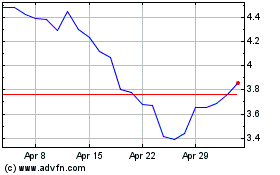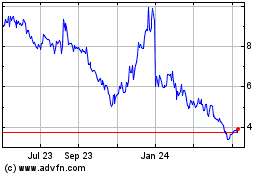Anavex Life Sciences Corp. (“Anavex” or the “Company”) (Nasdaq:
AVXL), a clinical-stage biopharmaceutical company developing
differentiated therapeutics for the treatment of neurodegenerative
and neurodevelopmental disorders including Alzheimer’s disease,
Parkinson’s disease, Rett syndrome and other central nervous system
(CNS) diseases, today announced that long-term clinical study
results from the U.S. ANAVEX®2-73-RS-001 (NCT03758924) study
demonstrate disease modifying effect of ANAVEX®2-73 (blarcamesine)
for adult patients with Rett syndrome.
Usually, symptomatic therapies treat the
symptoms of the disease but do not address the underlying cause of
the disease. Disease-modifying therapies target the underlying
cause of the disease.
ANAVEX®2-73 (blarcamesine) is an orally
available, small-molecule activator of the sigma-1 receptor
(SIGMAR1) which, data suggest, is pivotal to restoring cellular
homeostasis and promoting neuroplasticity.1
In the U.S. ANAVEX®2-73-RS-001 trial, of all 25
patients who both started and completed the randomized,
double-blind, placebo-controlled study, 24 patients voluntarily
enrolled in the 12-week open label extension (OLE) study, receiving
once daily oral liquid ANAVEX®2-73 (blarcamesine) formulation for
further evaluation of long-term safety, tolerability, and
effectiveness of ANAVEX®2-73 (blarcamesine) in patients with Rett
syndrome. The 12-week extension study was subsequently further
extended to 36 weeks.
The effect of ANAVEX®2-73 (blarcamesine) in the
double-blind part of the U.S. ANAVEX®2-73-RS-001 study was
maintained in the open label 12-week extension study. Results from
pharmacometric modeling of the full clinical data (i.e., from
baseline of the double-blind study to the end of the open label
extension study) indicates that the data are best characterized by
a combined symptomatic and disease modifying drug effect model.
Meaning that ANAVEX®2-73 (blarcamesine) exhibited both symptomatic
and disease modifying effects in the treatment of Rett syndrome in
a clinical setting.
Patients assigned first to ANAVEX®2-73
(blarcamesine) in the double-blind part of the study and who
continued on ANAVEX®2-73 (blarcamesine) during the open label
extension (OLE) study had a statistically significant (p = 0.01147)
reduction in disease severity when compared with patients assigned
first to placebo in the double-blind part of the study and who then
received ANAVEX®2-73 (blarcamesine) during the open label extension
(OLE) part of the study – a criterion for classification as a
disease modifying agent.
Continued improvement from the drug, as measured
with the Rett Syndrome Behavior Questionnaire (RSBQ) total score,2
was observed from the start of the double-blind study to the end of
the open label extension part for patients continuing on
ANAVEX®2-73 (blarcamesine). Patients previously on placebo, who
switched to ANAVEX®2-73 (blarcamesine) in the OLE part of the study
experienced improvement during the OLE part.
Additionally, disease progression, which is
defined as change in Rett syndrome disease severity with time, was
also reduced with long-term treatment with ANAVEX®2-73
(blarcamesine).
Patients assigned first to ANAVEX®2-73
(blarcamesine) in the double-blind part of the study and who
continued on ANAVEX®2-73 (blarcamesine) during the open label
extension (OLE) study had a statistically significant (p = 0.01752)
reduction in disease progression when compared with patients
assigned first to placebo in the double-blind part of the study and
who then received ANAVEX®2-73 (blarcamesine) during the open label
extension (OLE) part of the study – a criterion for classifying a
drug as a disease modifying agent.
Patients assigned to ANAVEX®2-73 (blarcamesine)
at the start of the double-blind study experienced more benefit of
drug effect than could be explained by symptomatic benefit alone –
hence, ANAVEX®2-73 (blarcamesine) exhibited both symptomatic and
disease modifying effect.
The reduction in annual rate of disease
progression for those patients, who continued on ANAVEX®2-73
(blarcamesine) was over 3-fold greater, relative to those who
switched from placebo to ANAVEX®2-73 (blarcamesine): Ratio of
reduction in annual rate of disease progression = 3.17 (Reduced
disease progression rate [Double-blind Part/ OLE — ANAVEX®2-73/
ANAVEX®2-73] = -1.383/year; Reduced disease progression rate
[Double-blind Part/ OLE — Placebo/ ANAVEX®2-73] =
-0.4357/year).
Anavex plans to submit the data for publication
in a peer-reviewed medical journal.
ANAVEX®2-73 (blarcamesine) has previously
received Fast Track designation, Rare Pediatric Disease designation
and Orphan Drug designation from the FDA for the treatment of Rett
syndrome.
“We believe these promising long-term clinical
results in adult patients with Rett syndrome provides further
support of the beneficial effect of ANAVEX®2-73 (blarcamesine) for
patients with Rett syndrome,” said Christopher U. Missling, PhD,
President and Chief Executive Officer of Anavex. “Rett syndrome is
a devastating, non-inherited genetic post-natal progressive
neurodevelopmental disorder that occurs almost exclusively in girls
and leads to severe impairments, affecting nearly every aspect of
the child’s life. We are looking forward to the upcoming read-out
of the ANAVEX®2-73 (blarcamesine) EXCELLENCE Phase 2/3 Rett
syndrome clinical trial in pediatric patients with Rett
syndrome.”
About Rett Syndrome
Rett syndrome is a rare, non-inherited genetic
postnatal progressive neurodevelopmental disorder that occurs
almost exclusively in girls and leads to severe impairments,
affecting nearly every aspect of the child’s life: their ability to
speak, walk, eat and even breathe easily. The hallmark of Rett
syndrome is near constant repetitive hand movements while awake. It
is characterized by normal early growth and development (6 to 18
months) followed by a slowing of development, loss of purposeful
use of the hands, distinctive hand movements, slowed brain and head
growth, problems with walking, seizures and intellectual
disability. There is currently no cure for Rett syndrome and
treatment of the disorder is symptomatic. Management of symptoms is
done through a multidisciplinary approach utilizing medication for
motor difficulties, breathing irregularities and control of
seizures through anticonvulsant drugs. Rett syndrome is caused by
mutations in the MECP2 gene and strikes all racial and ethnic
groups and occurs worldwide in approximately one in every 10,000 to
15,000 live female births.
About Anavex Life Sciences Corp.
Anavex Life Sciences Corp. (Nasdaq: AVXL) is a
publicly traded biopharmaceutical company dedicated to the
development of novel therapeutics for the treatment of
neurodegenerative and neurodevelopmental disorders, including
Alzheimer's disease, Parkinson's disease, Rett syndrome, and other
central nervous system (CNS) diseases, pain, and various types of
cancer. Anavex's lead drug candidate, ANAVEX®2-73 (blarcamesine),
has successfully completed a Phase 2a and recently a Phase 2b/3
clinical trial for Alzheimer's disease, a Phase 2 proof-of-concept
study in Parkinson's disease dementia, and both a Phase 2 and a
Phase 3 study in adult patients with Rett syndrome. ANAVEX®2-73 is
an orally available drug candidate that restores cellular
homeostasis by targeting sigma-1 and muscarinic receptors.
Preclinical studies demonstrated its potential to halt and/or
reverse the course of Alzheimer's disease. ANAVEX®2-73 also
exhibited anticonvulsant, anti-amnesic, neuroprotective, and
anti-depressant properties in animal models, indicating its
potential to treat additional CNS disorders, including epilepsy.
The Michael J. Fox Foundation for Parkinson's Research previously
awarded Anavex a research grant, which fully funded a preclinical
study to develop ANAVEX®2-73 for the treatment of Parkinson's
disease. ANAVEX®3-71, which targets sigma-1 and M1 muscarinic
receptors, is a promising clinical stage drug candidate
demonstrating disease-modifying activity against the major
hallmarks of Alzheimer's disease in transgenic (3xTg-AD) mice,
including cognitive deficits, amyloid, and tau pathologies. In
preclinical trials, ANAVEX®3-71 has shown beneficial effects on
mitochondrial dysfunction and neuroinflammation. Further
information is available at www.anavex.com. You can also connect
with the company on Twitter, Facebook, Instagram, and LinkedIn.
Forward-Looking Statements
Statements in this press release that are not
strictly historical in nature are forward-looking statements. These
statements are only predictions based on current information and
expectations and involve a number of risks and uncertainties.
Actual events or results may differ materially from those projected
in any of such statements due to various factors, including the
risks set forth in the Company’s most recent Annual Report on Form
10-K filed with the SEC. Readers are cautioned not to place undue
reliance on these forward-looking statements, which speak only as
of the date hereof. All forward-looking statements are qualified in
their entirety by this cautionary statement and Anavex Life
Sciences Corp. undertakes no obligation to revise or update this
press release to reflect events or circumstances after the date
hereof.
For Further Information:Anavex
Life Sciences Corp.Research & Business DevelopmentToll-free:
1-844-689-3939Email: info@anavex.com
Investors:Andrew J.
BarwickiInvestor RelationsTel: 516-662-9461Email:
andrew@barwicki.com
1 Advances in Experimental Medicine and Biology Volume 964
(2017) Sigma Receptors: Their Role in Disease and as Therapeutic
Targets.2 Rett Syndrome Behavior Questionnaire (RSBQ) total score
is key primary endpoint in the completed multi-center, double-blind
clinical EXCELLENCE Phase 2/3 study ANAVEX®2-73-RS-003
(NCT04304482) in pediatric patients with Rett syndrome. Topline
results from this study are expected in the second half of this
year.
Anavex Life Sciences (NASDAQ:AVXL)
Historical Stock Chart
From Mar 2024 to Apr 2024

Anavex Life Sciences (NASDAQ:AVXL)
Historical Stock Chart
From Apr 2023 to Apr 2024
